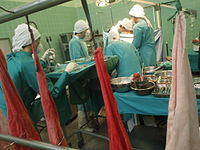
Photo from wikipedia
ABSTRACT Background The aim of this study was to describe the trends in the incidence, prevalence and survival of patients on kidney replacement therapy (KRT) for end-stage kidney disease (ESKD)… Click to show full abstract
ABSTRACT Background The aim of this study was to describe the trends in the incidence, prevalence and survival of patients on kidney replacement therapy (KRT) for end-stage kidney disease (ESKD) across Europe from 2008 to 2017. Methods Data from renal registries in 9 countries and 16 regions that provided individual patient data to the ERA Registry from 2008 to 2017 were included. These registries cover 34% of the general population in Europe. Crude and standardized incidence and prevalence per million population (pmp) were determined. Trends over time were studied using Joinpoint regression. Survival probabilities were estimated using Kaplan–Meier analysis and hazard ratios (HRs) using Cox regression analysis. Results The standardized incidence of KRT was stable [annual percentage change (APC): −1.48 (−3.15; 0.21)] from 2008 (146.0 pmp) to 2011 (141.6 pmp), followed by a slight increase [APC: 1.01 (0.43; 1.60)] to 148.0 pmp in 2017, although trends in incidence varied across countries. This increase was primarily due to a rise in the incidence of KRT in men older than 65 years. Moreover, as a cause of kidney failure, diabetes mellitus is increasing. The standardized prevalence increased from 2008 (990.0 pmp) to 2017 (1166.8 pmp) [APC: 1.82 (1.75; 1.89)]. Patient survival on KRT improved in the time period 2011–13 compared with 2008–[adjusted HR: 0.94 (0.93; 0.95)]. Conclusion This study showed an overall increase in the incidence and prevalence of KRT for ESKD as well as an increase in the KRT patient survival over the last decade in Europe.
Journal Title: Nephrology Dialysis Transplantation
Year Published: 2022
Link to full text (if available)
Share on Social Media: Sign Up to like & get
recommendations!